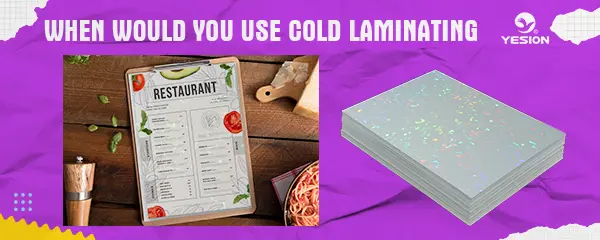
What can you do with cold laminating film?
2025-02-04
What surface can you use waterslide decals for?
2025-02-11Cold laminating is a process where a protective film is applied to a surface without the use of heat. It’s commonly used for preserving documents, artwork, and prints, offering durability and protection from wear, tear, moisture, and fading. Unlike hot laminating, which uses heat to melt and bond the laminate to the material, cold laminating uses adhesive that activates through pressure. Here are some situations:
When to use cold lamination?
1. Delicate Materials
Cold laminating is ideal for materials that can’t withstand high temperatures, such as delicate papers, photographs, or heat-sensitive documents. Heat laminating could cause these items to warp, melt, or discolor, but cold laminating ensures that the materials are preserved without damage.
2. Self-Adhesive Lamination
For projects that require a more user-friendly, no-heat process, cold laminating is great because it usually involves a self-adhesive laminate roll or pouch. This is a popular choice for home or small-scale businesses where people don’t have access to a heat-based laminating machine. It’s often used for smaller projects like menu cards, flyers, or business cards.
3. Quick and Convenient Lamination
Cold lamination doesn’t require a heat press, so it’s faster and easier for those who need a quick solution. If you need to laminate several items in a short amount of time but don’t need the level of durability or protection that hot lamination provides, cold lamination can be a more convenient and cost-effective option.
4. Heat-Sensitive or Large Items
Certain items, especially large documents, posters, or prints, may be too heat-sensitive or awkward to process with a traditional heat laminator. Cold lamination allows you to preserve larger pieces without worrying about uneven heat distribution or pressure, which could cause damage in heat-based laminating.
5. Temporary Lamination
Cold laminating can be useful when you need a temporary lamination or a less permanent solution. For example, promotional material, temporary signage, or items that will only be in use for a short period can benefit from cold lamination since it’s easier to remove or replace the cold laminate film compared to a heat-laminated item.
6. Cost-Effective for Small Businesses or Home Use
For small businesses, cold laminating machines are often more affordable and easier to maintain than their hot laminating counterparts. It’s perfect for those who only need to laminate occasionally and don’t want to invest in expensive machinery.
7. Flexible Applications
Cold lamination suits flexible applications where you can apply lamination to irregular surfaces, such as curved or textured materials. Since it doesn’t involve heat, you can apply it to a wider range of materials, including fabrics or soft films.
8. No Equipment or Power Requirement
Cold lamination is ideal in environments where you don’t have access to electricity or equipment that requires heat. This makes it perfect for mobile work situations, outdoor events, or projects on the go.
In summary, cold laminating proves particularly useful for handling delicate materials, managing small-scale lamination projects, enabling quick applications, and protecting items that cannot withstand exposure to heat. It’s a versatile, easy-to-use process that offers many benefits depending on the specific needs of your laminating task.
Related:
What is cold laminating film for?
Types of Cold Laminating Film
What can you do with cold laminating film?

